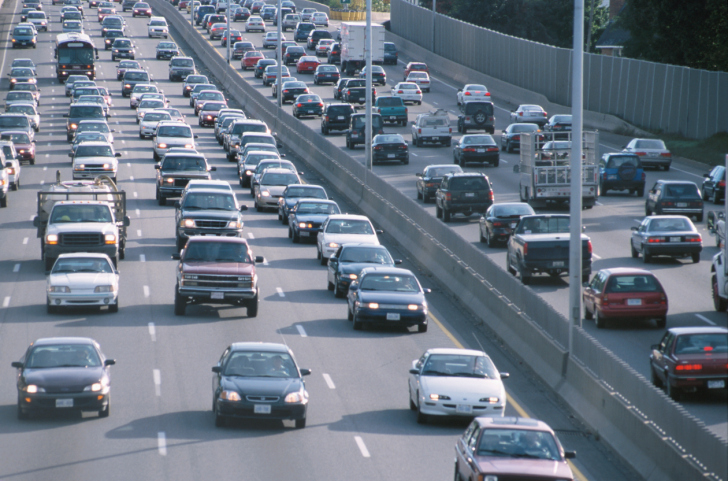Can salt (MgCl2) reduce air pollution from car traffic?
Can salt (MgCl2) reduce air pollution from car traffic?
 Car traffic is the main source for local air pollution in urban areas. In addition to the direct pollution from the exhaust gas (such as NOx and CO), cars also whirl up dust from the roads into the air, yielding high concentrations of small (PM2,5) and large (PM10) particles. The concentrations of such pollution components vary systematically by car traffic volume, but depend also on meteorological factors such as wind speed, wind direction, precipitation, air humidity, and temperature. NR has over a period of several years developed advanced statistical regression models for air pollution that has, amongst others, been used to quantify the effect of salting to reduce the amount of pollutant particles.
Car traffic is the main source for local air pollution in urban areas. In addition to the direct pollution from the exhaust gas (such as NOx and CO), cars also whirl up dust from the roads into the air, yielding high concentrations of small (PM2,5) and large (PM10) particles. The concentrations of such pollution components vary systematically by car traffic volume, but depend also on meteorological factors such as wind speed, wind direction, precipitation, air humidity, and temperature. NR has over a period of several years developed advanced statistical regression models for air pollution that has, amongst others, been used to quantify the effect of salting to reduce the amount of pollutant particles.
Empirical models for air pollution, traffic and meteorology
NR has modeled the systematic dependencies between the traffic related pollutions and the meteorological factors using so-called generalized additive models (GAM). These models are estimated from historical data, hourly observed from one or several measurements stations in Norwegian cities. These analyses are, for example, used to quantify effects of different air pollutants and to systematically compare pollutants across different measurement stations.
Salt as dust binding treatment
The Norwegian Public Road Administration uses a magnesium chloride solution on the roads to reduce the concentration of airborne particulate matter. The intention of these treatments is to reduce the concentration of particulate matter on days with extreme pollution.
NR has analysed the effect of a dust treatment using a magnesium chloride solution on the road inside a tunnel (Strømsås) and outside in the open air in Oslo (Kirkeveien). The first mentioned analysis had hourly data for the winter 2004/2005, while the latter used data from 2001-2009. To be able to detect the effect of the salting treatment, we have to adjust for all other effects that may have an impact on the air quality, such as precipitation and wind conditions. Particularly, we use our statistical models (i.e, the GAMs) to adjust for all other effects so that only the effect of the dust binding treatment remains.
The impact of the dust binding medium on the concentrations of particulate matter is clearly propitious for both sites, but clearer inside the tunnel than in the open air. As one would expect, it is largest immediately after applying the magnesium chloride, and diminishes steadily afterwards.
We estimated an effect (reduced pollution level) of 70% on the concentration of the coarse particles PM10–PM2,5 and 56% on the concentration of PM10 inside the tunnel Strømsås. The estimated effect on the fine particles PM2,5 is a modest 17%, and barely significant. The duration of the effect in the tunnel is estimated to 10 days, but with a rather large uncertainty (95% confidence intervals between 3 and 16 days). The effect at Kirkeveien is estimated to be 27% on the coarse fraction PM10–PM2,5 and 14% on the concentration of PM10. The estimated effect on the PM2,5 is, however, not significant at the open air site.
Publications
Aldrin, M. and Hobæk Haff, I. (2005): Generalised additive modelling of air pollution, traffic volume and meteorology. Atmospheric Environment, Vol 39, p. 2145-2155.
Aldrin, M., Haff, I. H. (2008). The effect of salting with magnesium chloride on the concentration of particulate matter in a road tunnel. Atmospheric Environment, Vol. 22, pp. 1762-1776.
Aldrin, Magne; Steinbakk, Gunnhildur Högnadóttir (2010). Effekt av salting på frysepunkt i veibanen basert på data fra 2005-2009. NR-note SAMBA/12/10.
Aldrin, Magne; Steinbakk, Gunnhildur Högnadóttir; Rosland, Pål (2010). Analyse av luftkvalitet og effekt av støvdemping baser på data fra 2001-2009. NR-note SAMBA/11/10.


 Hvordan komme til NR
Hvordan komme til NR Del på sosiale media
Del på sosiale media Personvernerklæring
Personvernerklæring